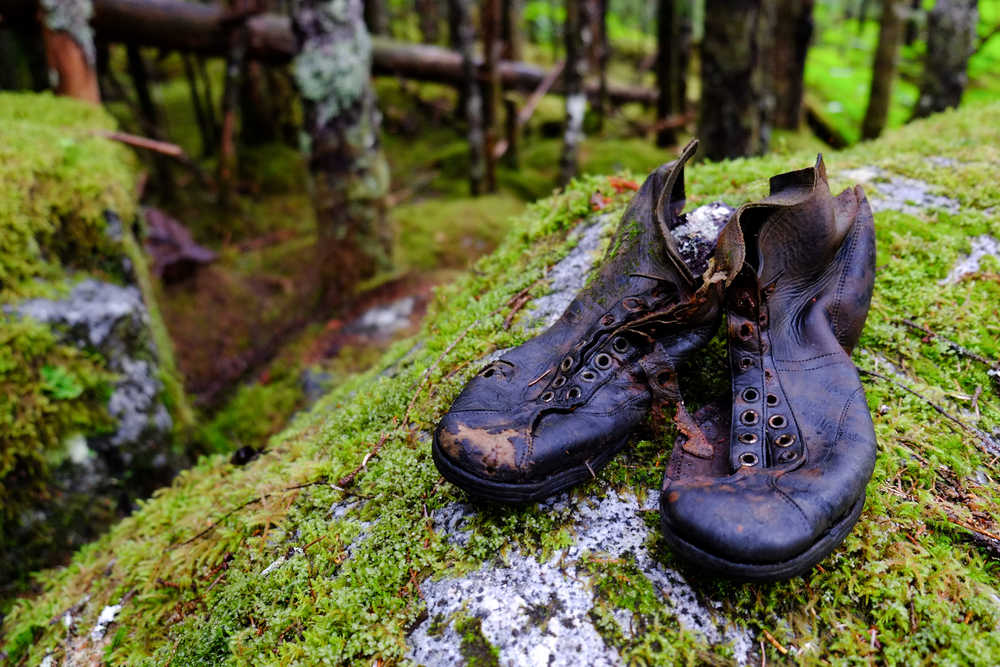In “Southeast Alaska: A Photographic Passage,” float houses and boat harbors appear through mist; oyster catchers stare through foliage. Some images are black and white, others glow with the blues and greens of moss, herring eggs and icebergs.
The images, scenes from the villages, towns, waters and fjords around Southeast Alaska, are the collaboration of Ernest and Larisa Manewal, a father-daughter duo.
“I’m nearly 80, so she wanted to do something with me before I became any more feeble than I already am,” Ernest said, laughing.
One of her main goals for the book was that it be timeless, Larisa said.
Larisa, an artist of many mediums who received a Bachelor of Fine Arts in Photography at the Brooks Institute in California, spent several months in Portland researching design and organizing the book.
Its sections are “Founding Cultures,” “The Tongass,” “Sea and The Sky,” “Relics,” and “Glacial Geology.”
“I just felt like those sections embodied most of what I want to say about Southeast,” she said.
Each photo is accompanied by a short description of the subject and where the photo was taken. One of her favorites is a young girl, dancing. The caption reads only “Tsimshian dance group / Metlakatla Native Reserve.”
Though the description of each photo is spare, each one means something different to her — and, at times, to its subject.
The photo meant something to the girl “at a very dark time,” Larisa said.
Larisa spent four of the last few years as a cultural and scientific expedition leader for Allen Marine’s cruises, and visited many smaller villages through her work with them, which helped her collect images. She didn’t manage to get as far north as Yakutat, but the book covers Metlakatla to Skagway.
The duo wanted to make the book as attractive to locals as to tourists, something that in this reader/viewer’s opinion, they’ve accomplished.
“I consciously put in a lot of rainy days,” Larisa said. “You don’t want to just have a sunny book when we live here. Same with winter versus summer.”
All the book’s images are things the reader could conceivably see if they visit the towns.
Ernest Manewal has lived in Sitka for 40 years. Larisa was born there.
Some of Ernest’s favorite Southeast Alaskan images are of wildlife and landscapes, he said.
“I like patterns, and things that are maybe a little off the beaten track,” he said.
One of his photos that made it into the book is of an old boat named “Arch Angel” in Pelican. It resonated with him because of Sitka’s one-time name of New Archangel, he said.
He’s attracted to eyes, as well — fish eyes, bird eyes. An oystercatcher in the book stares at the reader; Ernest liked the photo because the bird was both looking at him and trying to hide from him.
“It’s just a matter of being aware, and looking around, and taking it slowly, and observing what’s around you,” he said.
Ernest is also the author of another book Southeast Alaskans likely recognize: “Sitka: Between the Mountains and the Sea,” which covers “a little bit of everything” in Sitka and is almost sold out of its second printing, he said.
Ernest and Larisa printed 3,000 copies of “Southeast Alaska: A Photographic Passage,” and they don’t plan another print run, Larisa said.
She will be signing copies of the book at Hearthside Books downtown during First Friday. The books are also for sale for $29.95 at the Soboleff Building, Kindred Post in Juneau, and bookstores around Southeast Alaska.
• Contact CCW staff writer Mary Catharine Martin at maryc.martin@capweek.com.

